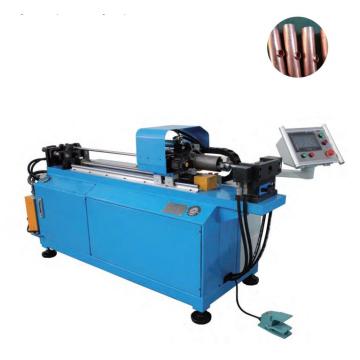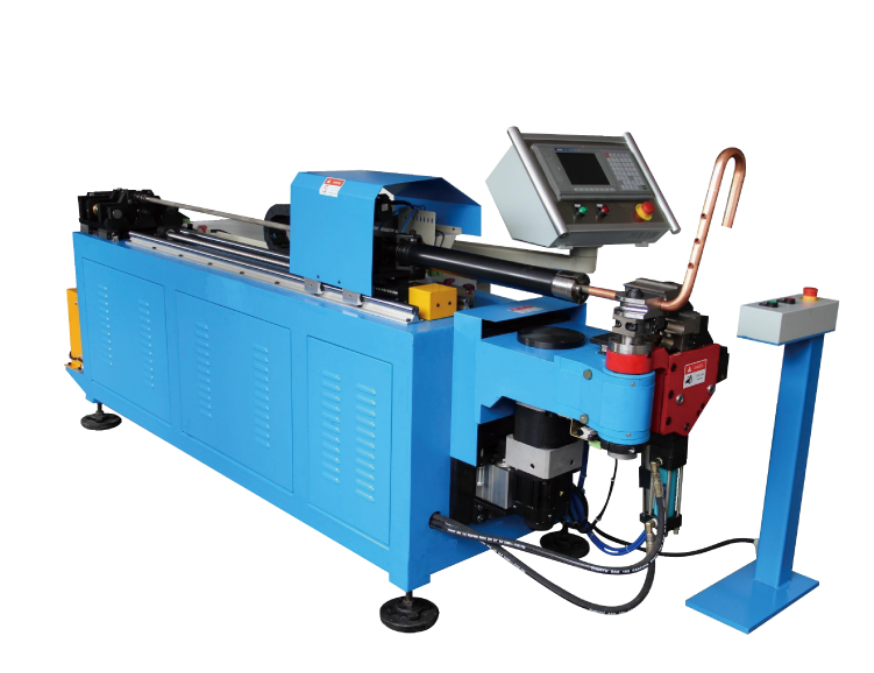
CNC Hole Punching And Flanging Machine
(Total 1 Products)-
Brand:XinchangMin. Order:1Place of Origin:Ningbo,ChinaHydraulic Hole Punching Machine for Metal Sheets: An efficient punching tool for metal sheet processingIn the vast field of Metal processing, welding and Punching are two key links. Various types of welding equipment perform their respective duties,...
A CNC Hole Punching And Flanging Machine is an advanced automated device designed to perform two key sheet metal operations—precision hole punching and edge flanging—in one integrated workflow. It processes metal sheets (steel, aluminum, copper) with high accuracy, creating holes (for fasteners, pipes) and raised flanges (to strengthen edges or enable connections) without switching between separate machines. Widely used in automotive, aerospace, and appliance manufacturing, it streamlines production and ensures consistent part quality.
Core Working Principle & Key Components
The machine combines CNC control with specialized tooling to execute sequential or simultaneous operations:
Sheet Feeding & Positioning: A motorized conveyor or hydraulic clamp feeds metal sheets (thickness: 0.5mm–10mm, size: up to 2m×4m) into the work area. CNC linear guides (±0.02mm accuracy) position the sheet precisely, using laser sensors to align with preprogrammed coordinates.
Hole Punching Unit: Features a turret with 10–30 interchangeable punch dies (diameter: 1mm–50mm). A hydraulic/pneumatic ram drives the punch through the sheet, creating clean holes—CNC control adjusts punch force (5–50kN) based on material thickness to avoid burrs or sheet deformation.
Flanging Unit: After punching (or simultaneously for some models), a flanging tool (customizable for height: 2mm–20mm, angle: 90°–135°) presses around the hole edge. It forms a raised, cylindrical flange that reinforces the hole (prevents tearing under load) and provides a smooth surface for fasteners or pipe connections.
CNC Control System: Uses a touchscreen panel to import CAD designs or set parameters (hole size, flange height, spacing). It stores 100+ programs, enabling quick job switching and ensuring repeatable accuracy across batches.
Key Advantages
Integrated Efficiency: Merges punching and flanging into one setup, cutting processing time by 40–60% vs. separate machines. For example, a sheet with 50 holes + flanges can be processed in 10–15 minutes vs. 30+ minutes with manual workflows.
High Precision: CNC positioning and tool alignment ensure hole spacing (±0.03mm) and flange uniformity (±0.1mm height) — critical for automotive chassis parts (where fastener alignment affects safety) or aerospace components (strict tolerance requirements).
Strength Enhancement: Flanges add 30–50% structural rigidity to punched holes, eliminating the need for additional reinforcing washers or brackets—reducing material costs and part weight.
Versatility: Interchangeable punch/flange tools adapt to diverse materials (mild steel, aluminum alloy) and part designs—from small appliance panels (e.g., fridge door holes) to large automotive body parts.
Typical Applications
Automotive Manufacturing: Creates flanged holes in steel/aluminum chassis for bolted connections, or in door panels for wiring harnesses—flanges prevent hole wear from vibration.
Aerospace: Processes thin aluminum sheets (1mm–3mm) for aircraft interior panels, punching flanged holes for rivets that maintain structural integrity at high altitudes.
Appliance Production: Punches and flanges stainless steel sheets for washing machine/dryer casings—flanged holes enable secure fitting of pipes or electrical components.
Construction: Processes steel sheets for HVAC ducting, creating flanged holes for pipe connections that ensure airtight seals and reduce leakage.
Operational & Safety Tips
Tool Calibration: Check punch die sharpness and flange tool alignment daily—dull punches cause rough holes; misaligned flanging tools create uneven edges. Replace tools after 1,000+ cycles (for thick steel).
Material Setup: Match punch force and flange pressure to material—too much force bends thin sheets; too little leaves incomplete flanges. Test with scrap sheets before full production.
Safety Measures: Install safety curtains around the work area; use emergency stops to halt operation if sheets jam. Operators must wear gloves and safety glasses to avoid metal shavings.
Program Validation: Simulate the CNC program (without tool engagement) to verify hole/flange positions—prevent costly errors on full sheets.
Maintenance Guidelines
Clean punch dies and flanging tools after each shift to remove metal debris; lubricate tool turrets weekly with high-temperature grease.
Inspect hydraulic hoses (for punch/ram) monthly for leaks; replace worn seals to maintain consistent force.
Calibrate CNC linear guides quarterly using laser measurement tools—misalignment reduces positioning accuracy.
In summary, the CNC hole punching and flanging machine redefines sheet metal processing by combining two critical operations with precision and efficiency. It is an essential tool for industries needing high-quality, reinforced metal parts, enabling cost savings and faster production cycles.

CNC Punching and Flanging Machine
The CNC Punching and Flanging Machine is a modern sheet metal processing equipment that integrates precise punching and flanging functions. It precisely controls the mold through a computer numerical control system (CNC), enabling rapid and high-precision punching and forming operations on metal sheets. It can also complete the flanging process in one go, which is used to make reinforcing ribs, installation edges or welding bevels. This equipment is widely used in the manufacturing of products such as chassis cabinets, elevators, doors and Windows, solar brackets and various ventilation ducts.
